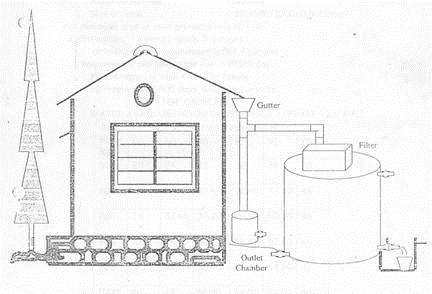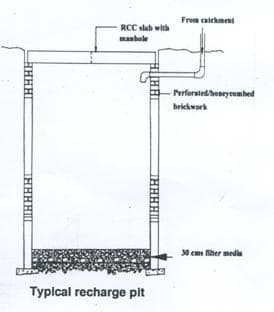Design Tips for Rainwater Harvesting Components
Design tips for rainwater harvesting components to collect and store the rainwater during rains in a overhead tank, or underground tank is discussed. Rainwater harvesting is natural in case of water collected in ponds in villages, but cities needs special methods to capture and store rainwater.
Design Tips for Collection of Rainwater
Water collected from roof can be a) stored for direct use b) allowed to infiltrate as groundwater recharge and c) combination of part storage and part recharge.
There are three structural components a) roof water collection system b) storage tank and c) recharge pit. The cost of the system will depends upon the cost of each of these components.
Water collected from the early showers are allowed to flow away since they contain some dirt. Once the roof top is washed clean by rainfall, the remaining water is collected. Nearly 80% of the rain fall can be easily harvested.
It is much easy to collect water from a sloping roof top simply by placing lateral gutters (semi-circular collecting pipe) to bring the collected water at one common point. Flat, concrete roof tops sometimes offer more serious challenges for collection of rain water.
Usually flat concrete roof tops are provided with at least 4 outlets (drain pipes) running along the four corners. This means the water collected from all the 4 corners pipes are to be brought at the common storage site through a network of additional pipe lines. This may spoil the aesthetics and increase cost. Also, there is a need to keep the roof top clean to prevent pollution of rain water by preventing people to use the roof top for various purposes including storing of junk items.
Design Tips for Storage Tank
Storage tanks could be constructed a) underground b) half underground and half over ground and c) over-ground depending upon its size and availability of land area.
Storage tanks could be made of a) PVC (ready made Syntex type), b) Ferro-cement tanks and c) cement concrete tanks. Cost not being a consideration, a) for small storage (<> 20,000 L), cement concrete tanks would be ideal.
Ferro-cement tanks are of least cost. These are tanks made from pasting rich cement mortar over a tank structure made from bending, shaping and binding 5 mm or so iron rods as reinforcement with an inside and out side layer of chicken mess (common wire net). Unlike cement concrete tanks, these are less prone to cracks/leakages and can be made in any shape (round, cylindrical etc.). Masons having experience in working with ferro cement are required to undertake this job. Many NGOs have such masons.
Storage tank to be used for drinking water must have a filter system at the entry point, a water extraction system for taking out water (tap, hand pump) and a draining system for cleaning the tank (manhole, drain pipe etc.) periodically.
A diversion arrangement (T-joint with valve) is required at the outlet of roof collected water pipe line to allow the water to be either disposed off (dirty water after initial rain) or stored in the storage tank through the filter system for use as drinking water.
Rain water is generally deficient in dissolved minerals necessary for human body. Some scientists have suggested that on prolonged use, low Calcium (Ca) in rain water may absorb some Ca from our body making our bones weak (also applies to some RO purified water). However, so far there has been no report of any adverse effect of using rain water as drinking water.
Design Tips for Groundwater Recharge
Artificial groundwater recharge is professed when a) there is excess source water available at site and b) quality of source water is compatible with the groundwater to be recharged.
It is always safe and desirable to construct a RWH structure, where water is partly stored for direct use and partly allowed to percolate to recharge groundwater. This helps in maintaining quality control of the water used for recharge.
The recharge structure is usually a 1- 2 cubic meter pit (could be larger when large quantity of water is to be recharged), filled with graded filter materials like cobbles, pebbles, gravel and sand in layers. The Objective is to let silt free good quality water to percolate.
Designing site specific filter beds are of critical importance. If the interstices of the filter are too small, water percolation will be slow. Conversely, filters with larger pores will allow faster percolation but water may not be free from suspended matters. For this reason, it is customary to have a pre-filter storage tank from where water is supplied to the pit as per its percolation capacity.
In hard rock areas (basalt and granite) where water occurs under water table condition in the weathered formation, there is no need to attach an extension pipe from the bottom of the recharge pit. Bur in areas where water occurs under water table condition at a deeper level (20 – 100 m bgl), it would be necessary to attach an extension pipe.
The purpose of the pipe is to allow the source water to join directly to the aquifer (water table) without being lost in the over-lying unsaturated zone. Ideally, the length of the pipe should be such that it ends near the water table which however is known to fluctuate seasonally. It is necessary, that the bottom most part of the pipe be a slotted pipe. Similarly, if the pipe extends upwards to the ground level, the top most pipe should also be a slotted pipe.
An abandoned (dry but clean) dug well in hard rock area can be used as an effective recharge pit provided, a) water table is not too far below from the bottom of the well and b) formation near the well bottom is porous and permeable and c) the water diverted in to the well for recharge is of good quality. Such recharge practice should be best done in consultation with a geohydrologist and better be avoided if there is a risk of contaminated water entering in to the well and finally to the groundwater.
Artificial groundwater recharge through a number of such recharge structures will not only increase water availability (raised water table) but will also improve water quality. If properly constructed and managed, it is possible to use a bore well both as a recharge well during the monsoon period and supply (abstraction) well during summer months.
All RWH structure will require regular monitoring and periodical (at least annual) cleaning and maintenance of its various components. It is advisable to rather not construct these RWH structures, if regular maintenance cannot be assured.












